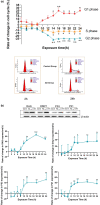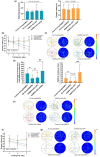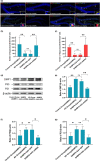Improved cognitive impairments by silencing DMP1 via enhancing the proliferation of neural progenitor cell in Alzheimer-like mice
- PMID: 35366382
- PMCID: PMC9124312
- DOI: 10.1111/acel.13601
Improved cognitive impairments by silencing DMP1 via enhancing the proliferation of neural progenitor cell in Alzheimer-like mice
Abstract
Alzheimer's disease (AD) is age-related progressive neurological dysfunction. Limited clinical benefits for current treatments indicate an urgent need for novel therapeutic strategies. Previous transcriptomic analysis showed that DMP1 expression level was increased in AD model animals whereas it can induce cell-cycle arrest in several cell lines. However, whether the cell-cycle arrest of neural progenitor cell induced by DMP1 affects cognitive function in Alzheimer-like mice still remains unknown. The objective of our study is to explore the issue. We found that DMP1 is correlated with cognitive function based on the clinical genomic analysis of ADNI database. The negative role of DMP1 on neural progenitor cell (NPC) proliferation was revealed by silencing and overexpressing DMP1 in vitro. Furthermore, silencing DMP1 could increase the number of NPCs and improve cognitive function in Alzheimer-like mice, through decreasing P53 and P21 levels, which suggested that DMP1-induced cell-cycle arrest could influence cognitive function.
Keywords: Alzheimer's disease; DMP1; neural progenitor cell; proliferation.
© 2022 The Authors. Aging Cell published by Anatomical Society and John Wiley & Sons Ltd.
Figures






Similar articles
-
AdipoRon improves cognitive dysfunction of Alzheimer's disease and rescues impaired neural stem cell proliferation through AdipoR1/AMPK pathway.Exp Neurol. 2020 May;327:113249. doi: 10.1016/j.expneurol.2020.113249. Epub 2020 Feb 15. Exp Neurol. 2020. PMID: 32070713
-
Suppressing DUSP16 overexpression induced by ELK1 promotes neural progenitor cell differentiation in mouse models of Alzheimer's disease.Aging Cell. 2025 Feb;24(2):e14372. doi: 10.1111/acel.14372. Epub 2024 Oct 21. Aging Cell. 2025. PMID: 39434411 Free PMC article.
-
Polysaccharides from Ganoderma lucidum Promote Cognitive Function and Neural Progenitor Proliferation in Mouse Model of Alzheimer's Disease.Stem Cell Reports. 2017 Jan 10;8(1):84-94. doi: 10.1016/j.stemcr.2016.12.007. Stem Cell Reports. 2017. PMID: 28076758 Free PMC article.
-
β-Amyloid precursor protein: function in stem cell development and Alzheimer's disease brain.Neurodegener Dis. 2014;13(2-3):96-8. doi: 10.1159/000353686. Epub 2013 Aug 7. Neurodegener Dis. 2014. PMID: 23942027 Review.
-
Neural stem/progenitor cells in Alzheimer's disease.Yale J Biol Med. 2016 Mar 24;89(1):23-35. eCollection 2016 Mar. Yale J Biol Med. 2016. PMID: 27505014 Free PMC article. Review.
Cited by
-
Co-Expression Network Analysis Identifies Molecular Determinants of Loneliness Associated with Neuropsychiatric and Neurodegenerative Diseases.Int J Mol Sci. 2023 Mar 21;24(6):5909. doi: 10.3390/ijms24065909. Int J Mol Sci. 2023. PMID: 36982982 Free PMC article.
-
Senescence accelerated mouse-prone 8: a model of neuroinflammation and aging with features of sporadic Alzheimer's disease.Stem Cells. 2025 Feb 12;43(2):sxae091. doi: 10.1093/stmcls/sxae091. Stem Cells. 2025. PMID: 39813151 Free PMC article. Review.
References
-
- Adamsky, A. , Kol, A. , Kreisel, T. , Doron, A. , Ozeri‐Engelhard, N. , Melcer, T. , Refaeli, R. , Horn, H. , Regev, L. , Groysman, M. , London, M. , & Goshen, I. (2018). Astrocytic activation generates de novo neuronal potentiation and memory enhancement. Cell, 174(1), 59–71.e14. 10.1016/j.cell.2018.05.002 - DOI - PubMed
-
- Bekinschtein, P. , Katche, C. , Slipczuk, L. , Gonzalez, C. , Dorman, G. , Cammarota, M. , Izquierdo, I. , & Medina, J. H. (2010). Persistence of long‐term memory storage: new insights into its molecular signatures in the hippocampus and related structures. Neurotoxicity Research, 18(3–4), 377–385. 10.1007/s12640-010-9155-5 - DOI - PubMed
MeSH terms
Substances
Grants and funding
LinkOut - more resources
Full Text Sources
Medical
Research Materials
Miscellaneous

